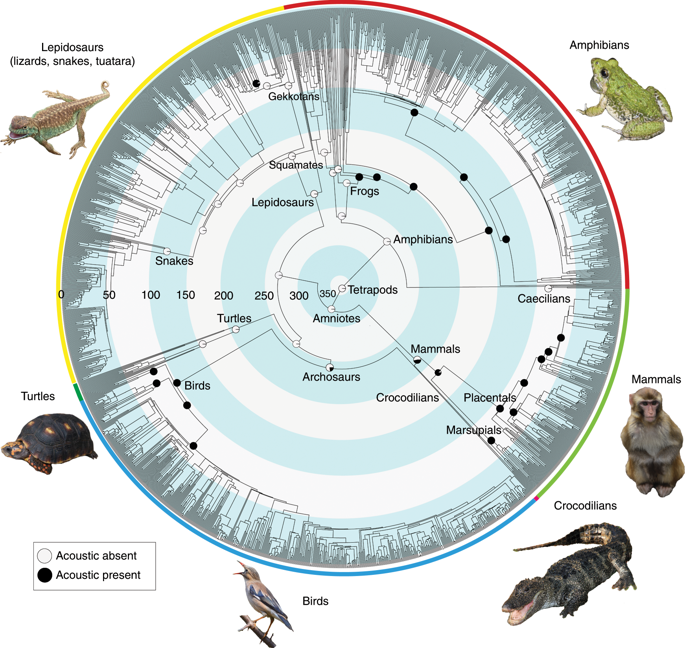当前位置:
X-MOL 学术
›
Nat. Commun.
›
论文详情
Our official English website, www.x-mol.net, welcomes your
feedback! (Note: you will need to create a separate account there.)
The origins of acoustic communication in vertebrates.
Nature Communications ( IF 14.7 ) Pub Date : 2020-01-17 , DOI: 10.1038/s41467-020-14356-3 Zhuo Chen 1, 2 , John J Wiens 2
Nature Communications ( IF 14.7 ) Pub Date : 2020-01-17 , DOI: 10.1038/s41467-020-14356-3 Zhuo Chen 1, 2 , John J Wiens 2
Affiliation

|
Acoustic communication is crucial to humans and many other tetrapods, including birds, frogs, crocodilians, and mammals. However, large-scale patterns in its evolution are largely unstudied. Here, we address several fundamental questions about the origins of acoustic communication in terrestrial vertebrates (tetrapods), using phylogenetic methods. We show that origins of acoustic communication are significantly associated with nocturnal activity. We find that acoustic communication does not increase diversification rates, a surprising result given the many speciation-focused studies of frog calls and bird songs. We also demonstrate that the presence of acoustic communication is strongly conserved over time. Finally, we find that acoustic communication evolved independently in most major tetrapod groups, often with remarkably ancient origins (~100-200 million years ago). Overall, we show that the role of ecology in shaping signal evolution applies to surprisingly deep timescales, whereas the role of signal evolution in diversification may not.
中文翻译:

脊椎动物声音通讯的起源。
声音交流对于人类和许多其他四足动物(包括鸟类、青蛙、鳄鱼和哺乳动物)至关重要。然而,其演化的大规模模式很大程度上尚未被研究。在这里,我们使用系统发育方法解决了有关陆地脊椎动物(四足动物)声音通讯起源的几个基本问题。我们表明声音交流的起源与夜间活动显着相关。我们发现声音交流并不会增加多样化率,考虑到对青蛙叫声和鸟鸣的许多以物种形成为中心的研究,这是一个令人惊讶的结果。我们还证明了声学通信的存在随着时间的推移而强烈保守。最后,我们发现声音交流在大多数主要四足动物群体中独立进化,通常具有非常古老的起源(约 100-2 亿年前)。总的来说,我们表明生态在塑造信号演化中的作用适用于令人惊讶的深时间尺度,而信号演化在多样化中的作用则可能不适用。
更新日期:2020-01-17
中文翻译:

脊椎动物声音通讯的起源。
声音交流对于人类和许多其他四足动物(包括鸟类、青蛙、鳄鱼和哺乳动物)至关重要。然而,其演化的大规模模式很大程度上尚未被研究。在这里,我们使用系统发育方法解决了有关陆地脊椎动物(四足动物)声音通讯起源的几个基本问题。我们表明声音交流的起源与夜间活动显着相关。我们发现声音交流并不会增加多样化率,考虑到对青蛙叫声和鸟鸣的许多以物种形成为中心的研究,这是一个令人惊讶的结果。我们还证明了声学通信的存在随着时间的推移而强烈保守。最后,我们发现声音交流在大多数主要四足动物群体中独立进化,通常具有非常古老的起源(约 100-2 亿年前)。总的来说,我们表明生态在塑造信号演化中的作用适用于令人惊讶的深时间尺度,而信号演化在多样化中的作用则可能不适用。











































 京公网安备 11010802027423号
京公网安备 11010802027423号